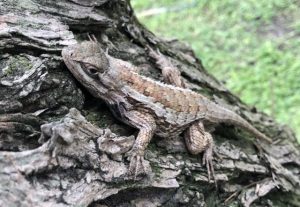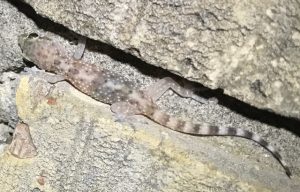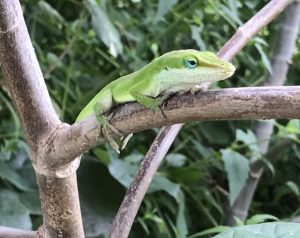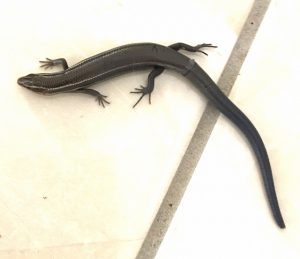
Lizards are ectotherms, which means their body temperature is the same as the environment around them. Lizards need to be warm; for most lizards, temperatures below 50 degrees Fahrenheit are too cold for them. In addition, during winter,there are a lot less bugs, insects, and spiders available — a lizard’s primary food supply.
Instead of being active when it’s cold, lizards will seek somewhere to be warm, such as a hollowed out log, pile of leaves, sticks and other debris, or burrow into the ground. They then will enter a state of lessened activity called brumation.
The word comes from Latin, bruma, meaning winter solstice, or midwinter plus the suffix, ation, from hibernation. The word was proposed by American zoologist Wilbur W. Mayhew, in 1965, to indicate winter dormancy in ectothermic vertebrates that demonstrate physiological changes independent of body temperature. By definition, brumation is a state of sluggishness and inactivity exhibited by reptiles, such as lizards and snakes, during extended periods of low temperature. They require less food to stay alive during this time.
Finding lizards, geckos, anoles, skinks, and whiptails in the garden is a sign of a healthy habitat. Once temperatures rise above 50 degrees Fahrenheit and the days turn sunny, these reptiles will again become active, helping to control the insect population in gardens, fields, and nature parks.
To make a garden lizard friendly, eliminate the use of pesticides which can poison lizards and their food source. Provide places for them to hide, keep warm in winter, and cool in summer by tossing a small log beneath shrubs and leaving leaf litter in secluded parts of the garden.
For the most part, these reptiles are harmless to humans; however, some of them are not opposed to biting the hand that tries to capture them. It’s always best to leave them alone and keep them in the garden where they can do the most good.
Here are a few of the local beneficial critters you can expect to see.
Texas spiny lizard is a tree-dweller favoring mesquite trees where its colors and scale patterns are camouflaged against the bark of the tree. An adult can be from seven to 11 inches in length. They have long toes with sharp claws suited for climbing trees, utility poles and walls. Active during the day, they feed on insects and other arthropods, like centipedes, millipedes, mites, ticks, mosquitoes, June bugs, grasshoppers, scorpions, and stink bugs.
Texas horned lizard is often confused with the Texas spiny lizard, although it is smaller, only reaching to six inches in length; it has a distinctively triangular shaped head with horns. Its coloring resembles the ground in its geographic region; they are rare in the Lower Rio Grande Valley, but not extinct. They do not climb trees; they run and forage for food on the ground and feed almost exclusively on harvester ants.

House geckos are introduced species; they prefer urban habitat with warm, humid climates. Mostly nocturnal, they can easily be seen climbing walls around houses with porch lights that have attracted insects. They are harmless to have in and around the home; they feed on cockroaches, termites, moths, flies, and spiders.
- Common house gecko generally is three to six inches in length and ranges from pale pink to light gray and may have darker patches of color.
- Mediterranean house gecko can grow to four to five inches in length, is gray or tan with pink or purple undertones, dark mottling, and striped tail.

Green anole is exceptionally entertaining. They can grow to seven inches in length, are active during the day and adept at climbing trees, shrubs, fences, and walls. They are frequently seen basking in the sun, lurking on small tree branches, or stalking insects. They can leap after prey or away from danger. They feed on crickets, cockroaches, moths, beetles, flies, and butterflies.

Skink has a dark-colored body of shiny, minute scales, with a colored stripe or stripes that run the length of the body. They have short legs and virtually no neck. Most skinks are active during the day. They prefer living on the ground. Skinks eat snails, slugs, cockroaches, grasshoppers, caterpillars, crickets, termites, and newborn mice.
Whiptail, such as the common spotted whiptail, prefers dry grassland and sandy soils with sparse vegetation. They are seven to nine inches long, tan or brown and have seven or eight white, yellow or green stripes lengthwise from neck to tail. Active in the daytime, they are constantly on the move, feeding on small beetles, ants, grasshoppers, and other arthropods.
Helpful resources in writing this article were biodiversity.utexas.edu, merriam-webster.com, reptilesmagazine.com, lizardsandfriends.org. britannica.com, thoughtco.com, sciencedirect.com, reptilefollower.com and petinsurance.com.